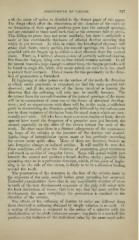Page 757 - My FlipBook
P. 757
PHENOMENA OF CARIES. 767
with the cause of caries as detailed in the former pages of this paper.
Tlie fungi which effect the dissohition of the elements of the tooth by
the formation of their special products grow into the natural openings,
and are confined to them until such time as the structure falls to pieces.
This falling to pieces does not occur suddenly, but there is ordinarily a
more or less considerable thickness of affected dentine covering that
which is yet normal. In this, in which the histological elements still
retain their forms nearly perfect, the natural openings are found to be
crowded with the fungus up to within a short distance from the normal
tissue. There is, I believe, always a zone of partially softened dentine,
free from the fungus, lying next to that which remains normal. In all
the lateral branches large enough to admit them, the fungus granules will
be found in single file, while very many tubuli are seen to be too small
to permit their entrance. Thus a reason for this peculiarity in the direc-
tion of penetration is furnished.
If, beginning at other points on the surface of the tooth, the direction
in which caries penetrates is examined, we find the same general rule
observed ; and if the structure of the tissue involved is known, the
direction that the softening will take may be readily foreseen. The
deviations from the normal direction of the natural openings of the tissue
will be in consequence of some one of the forms of abnormal develop-
ment ; and an acquaintance with these will be, in the main, a sufficient
guide in determining the direction probably followed by the carious pro-
cess in those instances of deviation from the usual course which are occa-
sionally met with. All who have made extensive studies of faulty devel-
opment have noted the frequency of a granular zone just beneath the
enamel, especially in the sides of the crown toward the neck of the
tooth. In other cases there is a distinct enlargement of the anastomos-
ing loops of the tubules at the juncture of the dentine and enamel.
Again, rings of interglobular spaces more or less perfectly encircling
the crown occur quite often. Many of these are, however, broken up
into irregular clumps or isolated patches. It will readily be seen that
these conditions will give the direction of penetration great variations
and result in cavities of irregular forms. Some will spread widely just
beneath the enamel and produce a broad shallow cavity possibly this
;
spreading may be in a particular direction, which, if the point of begin-
ning is on the side of the crown, is likely to be in a direction leading
arouiid the tooth.
The penetration of the structure in the line of the tubules leads to
the exposure of the pulp, usually before great spreading has occurred.
Extended examinations show that in any considerable number of cases
in teeth of the best development exposure of the pulp will occur with
the least destruction of tissue ; that is to say, that the more perfect the
development, the more completely the penetration is confined to the
direction of the tubules.
The effects of the softening of dentine by caries are different from
those observed in softening obtained by simple solution in an acid. If
a section of dentine is subjected to the action of a mineral acid, the
decalcification of its Avhole substance occurs ; but there is a marked dis-
position to the isolation of the individual tubes by the more rapid solu-


